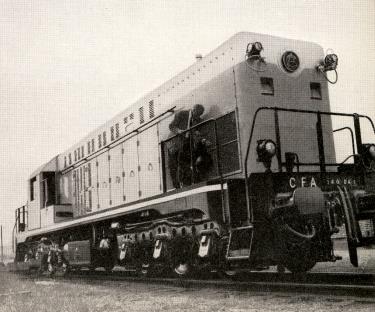and lined with wood, is located at the No. 2 end
of the locomotive with the boiler compartment.
This compartment, substantially built of steel
sheets and structural members, can be completely
removed as a unit. It provides space for housing
a suitable train heating boiler with necessary
controls and steam lines. Louvres furnish adequate
ventilation and doors, leading into the boiler
compartment, permit ready accessibility for in-
spection and maintenance. The locomotive is op-
erated from the left-hand side, with the control
stand accordingly located on that side of the cab.
Hand-operated ventilators, pneumatic window
wipers, fire extinguisher, ceiling light, and elec-
tric heaters all contribute to safety and comfort.
The engine hood is constructed of sheet steel and
can be removed as a complete unit, doors on both
sides give ready access to interior equipment,
and side hood louvres permit ample ventilation.
Hatches in the hood allow easy accessibility to
engine heads and valve actuating mechanism.
For cooling the engine a chain-driven centrif-
ugal pump, mounted on the engine, circulates
water through the radiator and engine. The radi-
ator is of suitable capacity for cooling the engine
jacket water and lubricating oil at full load.
Thermostatically controlled radiator shutters per-
mit the engine to operate at correct temperature.
The propeller type fan is driven by belts, which
are equipped with slack adjusters. At each end
of the locomotive, couplers of the screw link and
twin buffer type are placed.
Two six-wheel, swing-bolster, equalized motor
trucks are used. Pedestal type frames of cast steel
with pedestal jaws and center pin bearings are
embodied in an integral casting. Hollow tran-
soms conduct air from the blowers to the traction
motors. Automatic and straight air brakes oper-
ate on the end wheels. Each end of the locomo-
tive is equipped for train line connections. A hand
brake connected to one truck has its hand lever
placed in the cab.
Westinghouse force - ventilated, series - wound
traction motors with single-reduction gearing to
the axles, and mounted on two axles per truck,
operate at a gear ratio of 15.63. Two blowers sup-
ply air for cooling the traction motors. The front
blower is belt-driven from the diesel engine shaft
extension, and the rear blower is belt-driven from
the compressor shaft extension. Slack adjuster-
ment is provided for all belts.
The power unit is one Baldwin vertical, 4-cycle,
8 cylinder-in-line, supercharged diesel engine.
The cylinders with 12 3/4" bore x 15 1/2" stroke de-
velop their 1,500 rated horsepower at 625 rpm.
main generator, of the interpole type, is solidly
connected to the diesel engine crankshaft. It is
separately excited from the exciter generator, and
self-ventilated by cooling fans. The diesel engine
is started by motoring the main generator with
current supplied by the storage batteries.
The auxiliary generator set is mounted on top
of the main generator and driven from the main
generator by pulleys and "V" belts, with means
for slack adjustments and replacements. In addi-
tion to exciting the main generator, the auxiliary
set furnishes power for charging the storage bat-
tery, for cab heating, and for the control and light-
ing circuits.
The bed plate is of welded steel construction,
with an extension to support the main generator.
The cylinder liners are of the removable sleeve
type, made of centrifugally cast nickel iron of
uniform hardness, chrome plated on wearing
surface, and finished all over. The upper ends
of each cylinder liner are flanged to fit into a
counterbore in the frame. The lower ends extend
through the bottom of the water jacket. They are
free to expand independently of the frame and
are provided with rubber sealing rings.
Pistons are of conventional design, and are
made of heat-treated aluminum alloy castings.
Each piston is arranged with five compression
rings and three lubricating oil control rings, one
of the latter being located above the wrist pin
and two below.
Connecting rods are drop forged of heat-treated
alloy steel. They are fitted with interchangeable
bearing shells, having bearing metal centrifu-
gally cast in place. The wrist pin bearings are
-
Captain N. A. Concordet and Baldwin President Ralph
Kelly make a close inspection of the locomotive.
